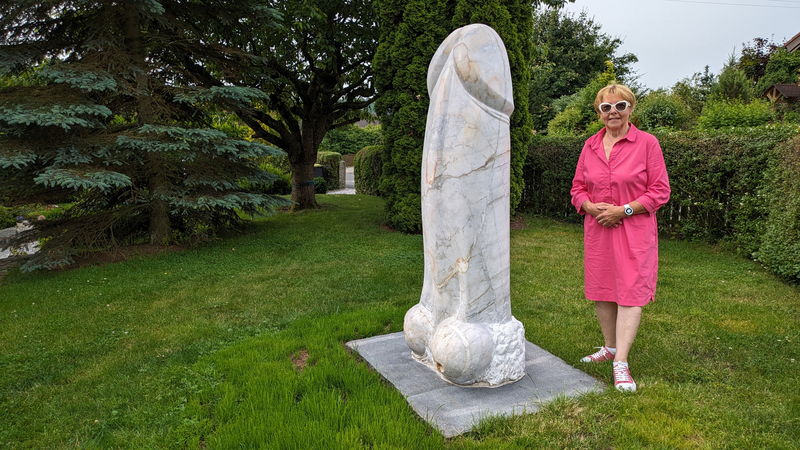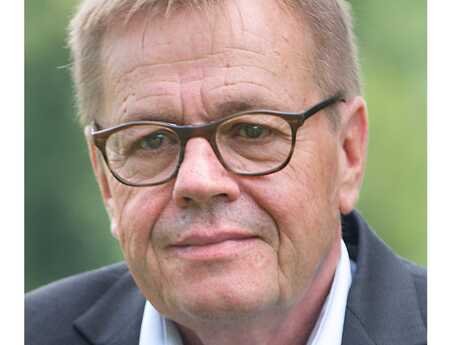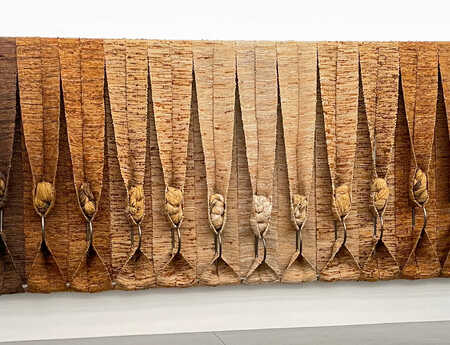We Each See what We See!
Marble, stone, and sex. Does penis content equal art? Or is it all about showing off? According to Ilona Vogel, the owner of a 1.80-metre-high, finely carved and polished penis sculpture that weighs two tonnes, a phallus has been a symbol of fertility and power with positive connotations since the beginning of time; an archetypal symbol. This may be so.

The sculpture, cut from white Wunsiedler marble, is sitting slightly elevated in the middle of a small grassy plateau on a hard concrete foundation in Köditz. This picturesque town in the northeast of Bavaria rarely makes the headlines. In July 2024, the time had come again: the stone phallus made of Wunsiedler marble in Ilona Vogel's front garden, a doctor specialising in skin and sexually transmitted diseases based in Köditz, has become a topic of conversation.
A few years ago, it was ironed shirts, a VW Golf, or a Trabant 601: carved entirely out of stone – either granite, marble, or sandstone; always large, always naturalistic – not always beautiful. Now it is a male penis, or rather a phallus – as the owner would prefer to hear it called.
Today penis content is in no short supply, both online and offline, from dick pics in the so-called social media to Till Lindemann's imposing penis cannon. Ms. Vogel's garden is not about sex or self-promotion. It is about art.
Unlike the female breast, the male genitals do not often feature in art. There are exceptions, however: Michelangelo and his famous David, for example. The stone statue of David carved out of Carrara marble is, to this day, the embodiment of the perfect (male) body. What is striking is the hero's penis: small, flaccid, and insignificant. Today we know that David's penis did not shrink in fear of Goliath. During the time of Michelangelo, a different ideal of beauty was applied. An ideal man was seen as rational, intellectual, and in control. A small penis did not mean that he did not have (good!) sex, but that a small penis is an inherent sign of coolness. A small penis meant modesty, asceticism, and yet still male strength. It's not just about size. Of course, there are also lavish depictions showing vast amounts of sexual debauchery and feasting and wild satires with overly large penises. The latter, however, enjoy – then as now – a rather poor reputation.
On the net and on the Rammstein stage, it's about showing off what you have, or at least what you think you have. It is about the logic of the fetish and the ‘ostentatio genitalium’, the ostentatious display of the genitals, as art history calls it.
The Köditz ‘thing’ is, by contrast, a work in the tradition of the ‘Nouveau Réalisme’ – a loose group of artists that emerged in France around 1960. The ‘New Realists’, a group centred around Jean Tinguely, Yves Klein, Daniel Spoerri, and Christo, lamented in their manifesto the sell-out and the fossilisation of the current (artistic) vocabulary and the previous styles. All that remained for them, as they said, was ‘the enchanting adventure of real seeing’. They were no longer interested in the reproduction of reality but in the actual objects themselves, their materiality, and the possibilities of their metamorphosis. In keeping with the tradition of Marcel Duchamp, they detached objects from their original environment and placed them in a new context. Their declared aim: to close the gap between art and life.
And such is the case in Ms. Vogel's garden: the creator of the penis von Köditz is the Upper Franconian sculptor Wolfgang Stefan. He studied under Wilhelm Uhlig in Nuremberg, works at the centre of excellence for stonemasonry and stone carving in Wunsiedel, and works as a designer for various companies in the glass and porcelain industry. Stefan approaches the man's best asset with a certain sophistication, without false modesty, just as nature created it and most (men) like to see it. The sculpture is made of Wunsiedler marble, a stone from Upper Franconia that had been excavated for 500 years in various quarries around Wunsiedel and in different colour variations. Alongside white varieties with grey to black veins, some stones also have a brown, green, orange, or yellowish colouring. Everywhere in the Fichtelgebirge, sculptures, gravestones, and other monuments crafted from this stone can be found. In the Middle Ages, the town of Wunsiedel was surrounded by a city wall made of marble. Legend has it some attackers were so irritated by the wall that they refrained from attempting to conquer the city; another beautiful story.
Ilona Vogel, the owner of the stone phallus of Köditz, does not see anything disreputable in the sculpture in her garden. On the contrary, the marble phallus enhances communication in the small town. The question on the minds of most onlookers is who the giant might have modelled on. And so art and life are intertwined. Who knows, maybe the phallus in Köditz helps to boost the self-esteem of those who feel insecure about their own penis. Which leaves the question of who is supposed to post dick pics then?




